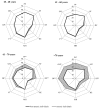Association of anemia with health-related quality of life and survival: a large population-based cohort study
- PMID: 30309850
- PMCID: PMC6395328
- DOI: 10.3324/haematol.2018.195552
Association of anemia with health-related quality of life and survival: a large population-based cohort study
Abstract
Anemia is highly prevalent, especially in older individuals. In selected populations, anemia has been reported to be associated with impaired survival and health-related quality of life. However, data on this impact in the general population are rare. Furthermore, discussions on the optimal definition of anemia have not been conclusive. We investigated these issues using survival data, scores from a health-related quality of life questionnaire (RAND-36), and hemoglobin concentration from 138670 subjects, aged 18-93 years, participating in the Lifelines cohort. Anemia was defined according to World Health Organization criteria and was further subclassified in participants over 60 years old. Anemia was present in 5510 (4.0%) of all 138670 subjects and 516 (2.8%) in the 18667 individuals older than 60 years. Anemia had no impact on overall survival and limited impact on health-related quality of life in individuals less than 60 years old. In contrast, in individuals over 60 years old anemia significantly impaired overall survival and health-related quality of life. The lower health-related quality of life was mainly observed in subscales representing physical functioning. Although consensus on the subclassification of anemia is lacking, our data suggest that particularly anemia of chronic inflammation was associated with worse overall survival and decreased health-related quality of life. Multivariate models confirmed that anemia was an independent risk factor for decreased health-related quality of life in older individuals. Finally, women with a hemoglobin concentration between 12.0-13.0 g/dL (considered anemia in men, but not in women) experienced a significantly lower health-related quality of life. This large, prospective, population-based study indicates that anemia is associated with worse overall survival and health-related quality of life in older individuals, but not in younger individuals. The findings of this study challenge the definition of anemia in women over 60 years old, and suggest that the optimal definition of anemia, in the perspective of health-related quality of life, in women over 60 years old should be altered to a hemoglobin concentration below 13.0 g/dL (8.0 mmol/L), which is comparable to that in men.
Copyright© 2019 Ferrata Storti Foundation.
Figures




Comment in
-
Anemia and adverse outcomes in the elderly: a detrimental inflammatory loop?Haematologica. 2019 Mar;104(3):417-419. doi: 10.3324/haematol.2018.208066. Haematologica. 2019. PMID: 30819832 Free PMC article. No abstract available.
References
-
- McLean E, Cogswell M, Egli I, Wojdyla D, de Benoist B. Worldwide prevalence of anaemia, WHO Vitamin and Mineral Nutrition Information System, 1993–2005. Public Health Nutr. 2009;12(4):444–454. - PubMed
-
- Stevens GA, Finucane MM, De-Regil LM, et al. Global, regional, and national trends in haemoglobin concentration and prevalence of total and severe anaemia in children and pregnant and non-pregnant women for 1995–2011: a systematic analysis of population-representative data. Lancet Glob Health. 2013;1(1):e16–25. - PMC - PubMed
-
- Guralnik JM, Eisenstaedt RS, Ferrucci L, Klein HG, Woodman RC. Prevalence of anemia in persons 65 years and older in the United States: evidence for a high rate of unexplained anemia. Blood. 2004;104(8): 2263–2268. - PubMed
-
- Penninx BW, Pluijm SM, Lips P, et al. Late-life anemia is associated with increased risk of recurrent falls. J Am Geriatr Soc. 2005;53(12):2106–2111. - PubMed
Publication types
MeSH terms
LinkOut - more resources
Full Text Sources
Other Literature Sources
Medical

